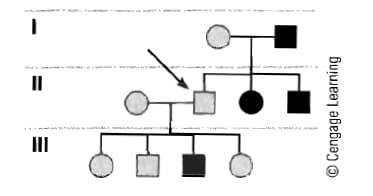Working with the definitions of penetrance and expressivity, analyze the following pedigree and assume that the father of the proband is homozygous for a rare trait. (Consider a rare trait here to be less than 1 in 30,000.) What pattern of inheritance other than autosomal recessive could explain this pedigree? In particular, explain the genotype and phenotype of the proband (arrow).
Working with the definitions of penetrance and expressivity, analyze the following pedigree and assume that the father of the proband is homozygous for a rare trait. (Consider a rare trait here to be less than 1 in 30,000.) What pattern of inheritance other than autosomal recessive could explain this pedigree? In particular, explain the genotype and phenotype of the proband (arrow).
Essentials of Pharmacology for Health Professions
7th Edition
ISBN:9781305441620
Author:WOODROW
Publisher:WOODROW
Chapter5: Abbreviations And Systems Of Measurement
Section: Chapter Questions
Problem 20CRQ
Related questions
Topic Video
Question
Working with the definitions of penetrance and expressivity, analyze the following pedigree and assume that the father of the proband is homozygous for a rare trait. (Consider a rare trait here to be less than 1 in 30,000.) What pattern of inheritance other than autosomal recessive could explain this pedigree? In particular, explain the genotype and phenotype of the proband (arrow).

Transcribed Image Text:II
II
© Cengage Learning
Expert Solution
Step 1
Sex linked disease
The disease which are caused by mutation in the sex chromosomes is known as sex linked disorder. Most of the sec linked disorder or disease are linked to X-chromosome.
Trending now
This is a popular solution!
Step by step
Solved in 2 steps

Knowledge Booster
Learn more about
Need a deep-dive on the concept behind this application? Look no further. Learn more about this topic, biology and related others by exploring similar questions and additional content below.Recommended textbooks for you

Essentials of Pharmacology for Health Professions
Nursing
ISBN:
9781305441620
Author:
WOODROW
Publisher:
Cengage

Medical Terminology for Health Professions, Spira…
Health & Nutrition
ISBN:
9781305634350
Author:
Ann Ehrlich, Carol L. Schroeder, Laura Ehrlich, Katrina A. Schroeder
Publisher:
Cengage Learning

Essentials of Pharmacology for Health Professions
Nursing
ISBN:
9781305441620
Author:
WOODROW
Publisher:
Cengage

Medical Terminology for Health Professions, Spira…
Health & Nutrition
ISBN:
9781305634350
Author:
Ann Ehrlich, Carol L. Schroeder, Laura Ehrlich, Katrina A. Schroeder
Publisher:
Cengage Learning